We didn't even leave Gyömöre until 3.30 this afternoon having spent most of the morning on the internet. It was a particularly happy collection of messages we received with the worrying exception of our friend in Brittany who continues to be very unwell. We are impressed with her fortitude facing permanent, exhausting treatment and our love and thoughts are with her for a speedy recovery.
It has been as suffocatingly hot as ever today and, having the cool house to ourselves, we were not inclined to rush away any sooner than necessary. So after finishing the plate of rétes for lunch we were seen off the premises by the dog – we felt quite guilty leaving her alone in the garden after we had become such good friends over the past few days. Our route took us by minor roads across the flat Kisalföld, through many pretty villages towards the Austrian border and the town of Sopron. It was here that Ian gave his paper at a local history conference some ten years ago that led to making many of the friendships we have renewed during our present visit.
We stopped at the attractive little town of Fertöd – not much more than a village really. Here there is the Esterházy castle. Yes, you have remembered correctly, we saw one yesterday in Pápa but they were a rich family and littered the Hungarian countryside with baroque castles. They are something of a mixed blessing today as they have all fallen into disrepair and restoration costs are phenomenal. Count Esterházy not only commissioned baroque churches and castles, he even employed composers to create works to be performed in the castles. So today Ian has led Jill a frustrating game of Haydn seek as we searched the little town for his residence in the bright hot sunshine of late afternoon. We eventually found both a plaque commemorating the work of Joseph Haydn and the castle of the Esterházys – magnificently restored at the front but rather dilapidated seen from the gardens behind.
 The home of Joseph Haydn, Fertöd
The home of Joseph Haydn, Fertöd Esterházy castle from the back, Fertöd
Esterházy castle from the back, FertödNeeding a campsite for the night we moved on to Hegykö near the edge of the national park beside Lake Fertö where we are camping on a small site beside the thermal baths. We arrived at 6.15pm to discover the baths closed at 7pm. Jill abandoned Ian and Modestine and literally ran across the space between the campsite and the baths to plunge joyfully into the swimming pool. It almost sizzled with her heat! There are several thermal baths there as well but these are boring places filled with overweight Germans clutching doctor's prescriptions, absorbing the mineral salts in the 55°C natural spa water, bursting with all sorts of healthy minerals that have turned the water a suspicious shade of yellow. After a few lengths of the swimming pool Jill felt human again and we spent the evening drinking the chilled white wine we had been given in Gyömöre and arguing about whether the factual, historical content of the blog should be given precedence over the emotional feeling for the environment. Should we be reporting about churches, architecture, museums and culture or should we be observing people, events, landscapes and everyday life? We try to keep a balance but as Jill writes the blog she decides. We'd be interested to know your views.
Lightning has been flickering through the trees for some time. It has now started to rain. It is the most wonderful refreshing sound in the world! The temperature has dropped and we feel so much better.
Friday 23rd June 2006 Fertöd, Hungary
What a difference a little rain can make! This morning the temperature was down to 27°C and the sky was overcast, though the brief shower yesterday is the best that has been offered. Filled with energy again, we left the campsite which really is a complete German holiday ghetto, and walked into the village. On the campsite German was the common language, every vehicle was German and all the signs were written in German only. It would be so easy to forget we are still in Hungary. The notice board advertised wellness clinics, massage, manicure, permanent make-up, saunas and cheap Hungarian dentists! Outside the campsite there is a completely different world with Hungarian villagers in front of their homes with mattocks and brooms cleaning their ditches or cutting their grass and ladies in aprons who wished us "jo nápot" rather than "Morgen" as we passed. The roadsides are lined with walnut and cherry trees heavy with ripe red fruit and many people have planted marigolds and roses beside their ditches.
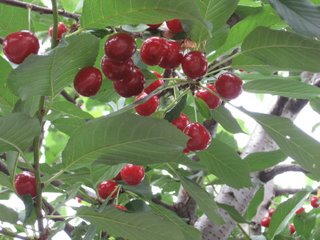 Roadside cherries, Hegykö
Roadside cherries, HegyköA kilometre down the road we found the village grocery store where we bought fruit and salad vegetables, bread and wine and stocked up on a few tins, including a couple of mystery ones with labels completely in Hungarian just so we could discover what was inside! As we strolled back towards the campsite, picking ripe cherries as we went, we passed a group of German people who gasped in astonishment at our bags of shopping and the two litre bottle of Tokaj Furmint wine under Jill's arm! We can only assume they never go shopping in Hungary, either bringing all their food with them or eating in restaurants.
Rejoining Modestine, we left the site and returned to Fertöd to visit properly the Esterházy castle. This was a very pleasurable experience. Although we had to go around with a Hungarian group we were given a translated sheet and left to go at our own speed. Count Esterházy was certainly a wealthy man and entertained royalty in his castle which was modelled on Versailles and Schönbrunn. Occupied by German troops in the Second World War, it was left in a dilapidated state, robbed of its valuable possessions and it is only now gradually being restored to its former glory. It is quite magnificent with painted ceilings, gilded mirrors, marble floors, rich tapestries and beautiful furniture representing the best taste of 18th and 19th century Europe - glass chandeliers from Italy, chairs from France and inlaid chests from England.
 Wrought iron gates to Esterházy castle, Fertöd
Wrought iron gates to Esterházy castle, Fertöd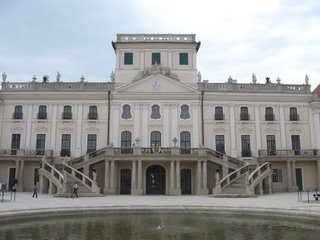 Front entrance to Esterházy castle, Fertöd
Front entrance to Esterházy castle, Fertöd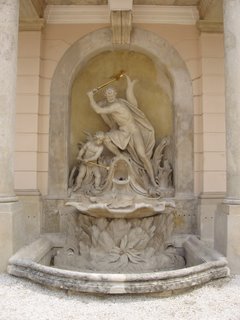 Fountain, Esterházy castle, Fertöd
Fountain, Esterházy castle, FertödWe discovered there was to be a concert in the magnificent castle music room this evening and we determined to go. This meant finding a campsite nearby and the only one around was closed for rebuilding. It was attached to a hotel and when we explained why we were so anxious to stay within walking distance of the castle they said we could stay in the hotel grounds and we could have the key to the sauna which has a shower in. So we are the only people around. We are even linked up to the electricity supply!
We had lunch in a restaurant near the castle. The set menu was quite pricey being 950 forints rather than the 550 menus we have become used to! (950 forints is around £2.50!) We were served big bowls of tomato soup followed by thick slices of roast beef in a cream sauce with boiled potatoes and salad. It was a struggle to finish and quite delicious.
Fertöd once stood on the edge of Lake Fertö, now a World Heritage Site, but during the mid nineteenth century the lake gradually dried up leaving acres of wetlands and reed beds which are a haven to bird life. We tried to find the lake by driving along quiet, empty roads through these wetlands, which lead up to the border with Austria but offer no way through. The flat plain that now covers what was once the lake is rather like the puszta, used for grazing curly horned sheep and buffalo with isolated, long, low, thatched farmsteads. A viewing platform permitted us to watch the many water fowls feeding and wading in the shallow salty lake so far from the sea, right in the centre of Europe.
 Drainage channel on the edge of Lake Fertö
Drainage channel on the edge of Lake Fertö Wildfowl on Lake Fertö
Wildfowl on Lake Fertö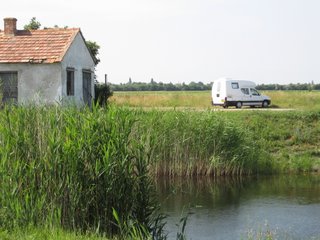 Modestine goes to Lake Fertö
Modestine goes to Lake Fertö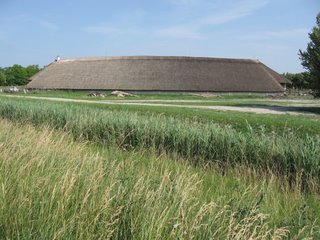 Typical thatched building of the wetlands of Lake Fertö
Typical thatched building of the wetlands of Lake FertöUp at the Austro-Hungarian border we found the little village of Fertöújak, its one street lined with cherry trees. In a garden paddock we were surprised to discover a couple of ostriches fluttering their eyelashes at us!
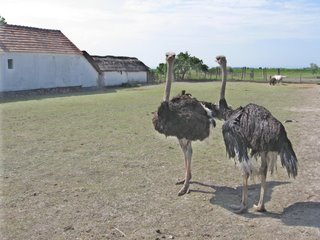 Hey, it's Austria not Ostrichia in the field behind you!
Hey, it's Austria not Ostrichia in the field behind you!There was just time to return to the campsite to spick and span ourselves up and enjoy a glass of wine before walking across to the castle for the concert entitled "J. Haydn and the Czech masters of his age." In addition to Haydn it included works by J. Myslivecek and Fr. V. Kramar. The audience was small, less than 20 people and, apart from us, they seemed to all be Hungarian. Nevertheless a programme specially prepared in English was given to us. The chamber ensemble was made up of Czech soloists from Musica Florea who played on period instruments and the concert really did take place in the wonderfully extravagant rococo music room with a vista over the lawns and gardens behind. As the sun went down, candles reflected in the large gilt mirrors lit the ornate walls. It was a really magical experience and the highlight of an already full and happy day.
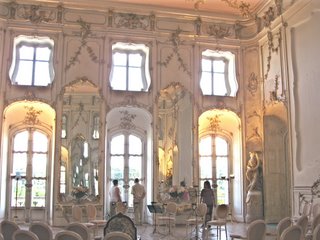 Music room at Esterházy castle, Fertöd
Music room at Esterházy castle, Fertöd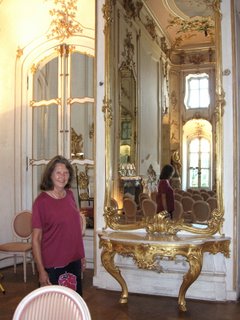 Jill doesn't often get to have her photo taken in such impressive surroundings! Esterházy castle, Fertöd
Jill doesn't often get to have her photo taken in such impressive surroundings! Esterházy castle, Fertöd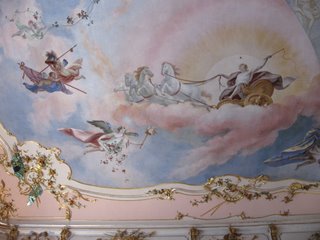 Apollo silently crosses the ceiling during the concert! Esterházy castle, Fertöd
Apollo silently crosses the ceiling during the concert! Esterházy castle, Fertöd Musica Florea, Fertöd
Musica Florea, Fertöd Concert interval, Esterházy castle, Fertöd
Concert interval, Esterházy castle, Fertöd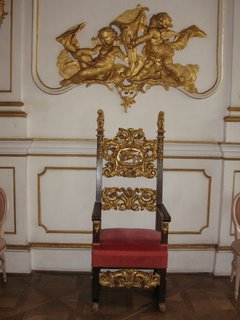 Not our seat at the concert! Fertöd
Not our seat at the concert! Fertöd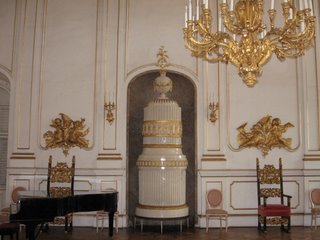 Ceramic stove for winter heating, Esterházy castle, Fertöd
Ceramic stove for winter heating, Esterházy castle, Fertöd Jill particularly liked this mirror on the stairs, Esterházy castle, Fertöd
Jill particularly liked this mirror on the stairs, Esterházy castle, Fertöd Jill seen through a glass darkly, Esterházy castle, Fertöd
Jill seen through a glass darkly, Esterházy castle, Fertöd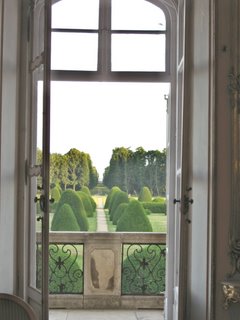 Gardens seen from the music room, Esterházy castle, Fertöd
Gardens seen from the music room, Esterházy castle, FertödSaturday 24th June 2006 Sopron, Hungary
This morning we asked at the hotel if we could join the guests for breakfast rather than eating in the heat of the sun outside Modestine. It was a "help yourself" buffet with scrambled eggs, cold meats, cheese, rolls, coffee and jam. It turned out to be not very nice and Jill was obliged to tip the tepid instant coffee into a nearby flower tub it was so unpalatable! The rolls were dried out and white, the cheese was elastic plastic and the ham was spam. Still it was an experience and as we have said, food prices are ridiculously cheap in Hungary. All in all though, the experience of camping at the hotel was very pleasant and was the finishing touch to our lovely day yesterday.
Unfortunately, even for us, not every day can be filled with exciting experiences and there must be low moments as well as exhilarating ones. Today we have been back to the misery of the heat and we are both feeling very fed up. Neither of us likes the hot weather and it has definitely spoilt our recent time in Hungary. It is almost certainly the most trying time of our entire year and for the first time we have thought with longing for our cool garden in Exeter and a swim in the sea at Budleigh Salterton. It is our own fault of course as we had intended to be well away from Hungary by now but the cool, wet weather we experienced up to leaving Debrecen lulled us into believing we could easily cope with a bit of warm sunshine if it ever arrived. We love the country and the people and did not want to rush away sooner than we had to. Unfortunately we have left it too late and it will almost certainly be very hot as we travel north. Okay, moan over.
Our first destination was Nagycenk, just a few kilometres further along the road from Fertöd towards Sopron. Here there is a little privately run narrow gauge railway where children sell you tickets for rides in little old carriages pulled by cute little steam and diesel engines. The departing train was packed to the gunnels with school children and we were told we would need to wait an hour for the next one. So we gave the ride a miss though enjoyed looking around the collection of engines parked in the station grounds. For Martin and Penny, for Diana and any other closet railway buffs travelling with us we include a few photos to brighten your day.
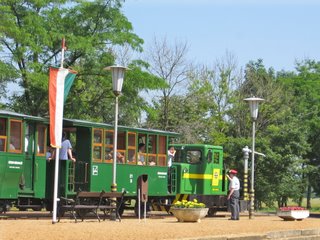 The train standing at the platform is about to depart, Nagycenk
The train standing at the platform is about to depart, Nagycenk Some of Thomas's tank engine friends, Nagycenk
Some of Thomas's tank engine friends, Nagycenk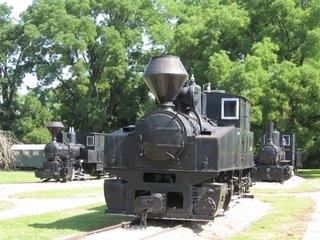 We knowledgably claim this to be a saddle tank engine, Nagycenk
We knowledgably claim this to be a saddle tank engine, Nagycenk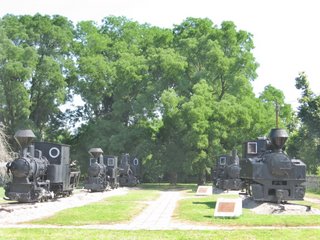 Exhibits at the railway museum, Nagycenk
Exhibits at the railway museum, Nagycenk Carriages hoping to be pulled by one of those handsome engines, Nagycenk
Carriages hoping to be pulled by one of those handsome engines, Nagycenk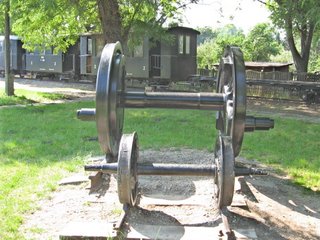 Difference between standard gauge and narrow gauge track, Nagycenk
Difference between standard gauge and narrow gauge track, NagycenkNearby is the country house of Count István Széchenyi. His wife, bless her, had an avenue of plane trees planted up to the gates and these gave welcome shade to park Modestine and for us to reach the grounds. There help ended and we had to struggle across the heated forecourt of the otherwise pretty gardens to the shelter of the house. Once inside however, we lingered as long as possible, making our way through the home of the country's great benefactor, innovator and politician. It is really a shrine to his memory - Hungary really does respect its past heroes whether military, political, cultural, scientific or humanitarian. In 1996 the librarians at the local studies conference in Sopron laid a wreath at his mausoleum near to his home. Where might British librarians lay wreaths - on the tomb of Andrew Carnegie perhaps, but would they bother? (Ian wonders. Jill wouldn't bother.)
 Home of Count István Széchenyi, Nagycenk
Home of Count István Széchenyi, Nagycenk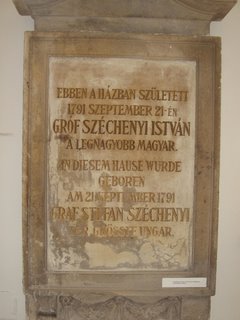 Commemorative plaque to Count István Széchenyi, Nagycenk
Commemorative plaque to Count István Széchenyi, NagycenkIstván Széchenyi (1791-1860) is always referred to as "the Greatest Hungarian" although, compared to the nearby Esterházy Palace, his residence is much more modest, a two storey building rebuilt in a classical style in the 1830s. The Count himself seems to have been associated with almost all aspects of progress in Hungary in the first half of the 19th century. The museum rooms in the house describe in detail his contribution to, among other things, the National Library, the National Theatre, horseracing (introduced from England to help improve Hungarian horses), railways, bridges (he promoted the first bridge across the Danube at Budapest), steamships, river drainage and navigation, agricultural improvement and so on. All this was accomplished against the difficult background of Austrian domination and revolutionary struggle. The difficulties at one stage drove him into an asylum and his eventful life ended in suicide when the Austrian authorities pursued him as the author of a seditious publication.
Eventually we left the shelter of the house and after cold drinks in the adjoining wing, now a restaurant, we continued towards Sopron. On the way we turned off down a little road leading to the elusive Lake Fertö. After several kilometres of reed beds we eventually reached open water. Here there was a car park but no shade for Modestine. However, hopeful of a swim we parked to investigate. The lakeside was crowded with people frying in the heat; the water was a dirty brown and crowded with children playing in the green scum around the edge of the lake. Nowhere near the shore was the water deeper than two or three feet. It looked a very unsavoury place in the glaring heat of early afternoon. We were quite taken aback that this is what Hungarians did for their holidays and it was at this moment that it really struck us how lucky we are to live in such a pleasant place as Devon, within easy reach of the sea, cliff top walks, open moorland, shady woods and the cool country gardens on National Trust properties.
 Lake Fertö is finally discovered hidden in the reeds
Lake Fertö is finally discovered hidden in the reeds World Heritage site, Lake Fertö
World Heritage site, Lake FertöCome on in, the water's lovely
Deciding that chlorine laden swimming pools were safer than algae-ridden lakes we abandoned hopes of a swim and found a dark, shady bar with a ceiling fan – the only fan we have seen anywhere in Hungary. Here we sheltered from the heat over a very long lunch. The meal was delicious of course but we feel we are eating too much in this hot weather simply because there is nothing else we are capable of doing. We are totally drained of energy.
Finally we continued to Sopron, our intention being to find a campsite and investigate the possibility of using it as a base for the railway station to visit Vienna. Remembering how difficult the heat made it to enjoy Budapest we have reservations about coping with either Vienna or Prague but always hope for another day like yesterday. The first campsite we found had closed down and the only other site is the most expensive we have encountered in Hungary. We have no choice as there is nowhere else. It is pleasantly laid out but the facilities are old and not very clean. The swimming pool, which we are obliged to pay for, is closed, supposedly because of a technical fault. As with all the other sites in Hungary, there are too many hungry mosquitoes. It is also miles out from the centre of the town.
Germany seems to have been playing Scotland in the World cup if the roars coming from a group of nearby German campers is anything to go by. They have been shouting and bellowing as they watch their satellite TV. We suspect Scotland won, as the unwelcome sound of their TV has just played "Scotland the Brave" – a bit surreal just south of the Vienna Woods – and they have lapsed into silence, Praise the Lord!
Sorry this is such a grouchy entry but it's nothing a few snowflakes cannot cure.
Sunday 25th June 2006 Vienna, Autria
We are now camping on the western edge of Vienna after a hot and sticky drive from Sopron. So while Ian refreshes in the shower, Jill is taking the opportunity to catch-up on the day.
Well it will come as no surprise to know that the heat continues. However, there is a hot dry breeze here which certainly helps make things less sticky and we have managed to find some shade on the site to position Modestine though it is still unpleasantly warm inside.
This morning we drove down into Sopron and parked beneath some trees before walking into town. It really is a very attractive little place, just a few kilometres inside Hungary. Jill was most impressed to see the baroque town hall in the heart of the old town where Ian gave his paper at the library conference that led to us returning here today.
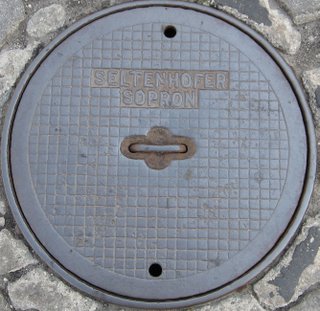 A tame offering from Sopron
A tame offering from Sopron There are even Roman remains in Sopron
There are even Roman remains in Sopron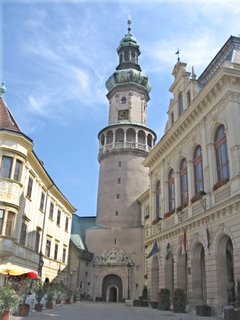 Fire tower and Town Hall (right), Sopron
Fire tower and Town Hall (right), SopronThere were whole streets of modest baroque building and while most of the churches were baroque there were a few gothic ones which came as rather a pleasant surprise. They seem so simple and graceful after the elaborate cupolas, turrets and domes of most of churches and buildings we have visited since being in Hungary.
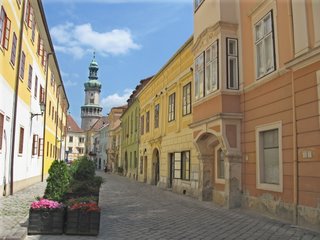 Typical street in Sopron
Typical street in Sopron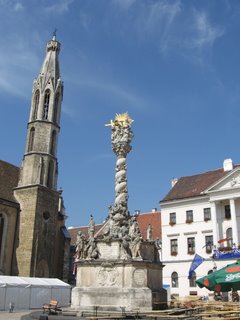 Plague column and Gothic church in the main square, Sopron
Plague column and Gothic church in the main square, SopronWe were surprised to see the American flag flying in the main square. We know George Bush has been following us around, arriving in Budapest just after we had left, but it seemed unlikely that he would trouble to pursue us to the tiny town of Sopron. It transpired there was a "New Orleans meets Sopron" activity taking place. As we sat in the shade with some iced water an American style religious service took place across the square under a huge poster claiming "New Orleans welcomes you". The sermon and prayers of the Hungarian preacher man were supported by a choir of deep south spiritual singers. The service was attended by lots of happy, clappy Hungarians who seemed somewhat taken aback by the really deep bass voice of the black soul singer. We felt quite smug as we joined in with the words as well as the clapping as the choir gave all they'd got to "He's got the whole world in His hands".
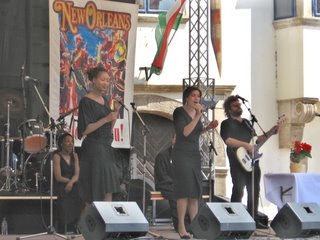 Amazing Grace, Sopron
Amazing Grace, SopronRealising we still had 15,000 forints to use up before we crossed the border, and it was approaching lunch time we thought it might be fun to see inside the English Pub on the corner. Actually we were quite impressed with just how English it looked with traditional patterned carpets, dark woodwork, hunting scenes on the walls, a county map of Oxfordshire and some British Rail posters for Chester and Shrewsbury. Consternation broke out though when we asked if they actually had a menu in English! We had three waiters trying nervously to explain the dishes until we put them out of their agony by saying we could understand in German but were just curious to know how English the pub really was.
 English pub, Sopron
English pub, SopronIf you want to try really good local dishes, go to an English pub. That maxim is as valid in Hungary as in Britain. The meal we were served was very nice though anything but English!
Next we went to the mediaeval gothic synagogue! This was in a little side street and had been largely reconstructed. It was an interesting experience and we were given a leaflet explaining the background to the Jewish religion and its traditions, enabling us to understand what we were looking at. The main room held the scrolls of the Jewish law in a deep alcove with the traditional Jewish menorah or candelabra to one side. In the centre of the room stood the dais from where the scroll would have been read out to the faithful gathered around. The room for the women was behind with narrow windows to enable them to follow the service. In a courtyard nearby was a deep covered area which would have been filled with water for ritual cleansing.
 Mediaeval synagogue, Sopron
Mediaeval synagogue, SopronWe rejoined Modestine and headed for Austria, stopping at a garage and handing all our remaining forints to the garage attendant indicating he should not exceed that amount when filling the tank. There were at least three forints left when he'd done, which hardly amounted to a tip for him, but he insisted on cleaning the windscreen for us anyway as he waved us off towards the border. A nicer way to leave Hungary than being wheel clamped as we were leaving France!
